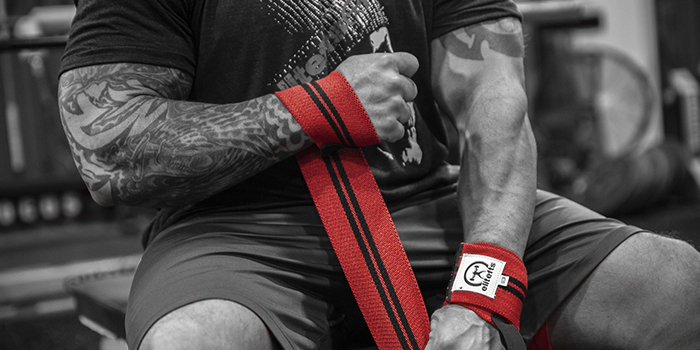
After posting to his Instagram about wrist wraps, Dave Tate received more and more questions about them. Rather than address each of them separately, he decided to explain as much as he could about wrist wraps in a video. Specifically speaking, this video:
Wrapping Wrists for the Bench Press
Dave starts with wrapping for the bench press because that’s what wrist wraps are most commonly used for. When wrapping for the bench press, don’t stick your thumb through the thumb loop because your thumb’s going to get stuck.
For Dave, wrist wraps are a luxury. When he first started lifting, wrist wraps didn’t even exist yet; instead, he’d cut knee wraps in half. No thumb loops required!
Rather than sticking your thumb through the loop, Dave suggests using that loop as an anchor. Grab the thumb loop and hold it. That first wrap going down and around your wrist should be angled and at the top of your hand — a legal way to wrap for the bench.
Once the wrap is at the top of your hand so you can wrap through, you’re able to get a more cast-like kind of wrap... and then you let go and hold down.
Voila! It’s a legal wrap with no way for your wrist to move backward.
Another option: the belt strap loop. It’s a multipurpose loop in which you feed the wrap through and then pull it from there and wrap it around your wrist. Belt strap loops are nice training loops, but it doesn’t give you that nice angle across the top of your hand like the first way did.
Belt strap loops are ideal for training, not competing, which is one of the reasons why elitefts will be discontinuing belt strap loops.
But if you’re a belt strap loop aficionado, don’t worry — you can use the thumb loop the same way you would a belt strap loop on the lighter wrist wraps.
You can also use wraps as compression cuffs by wrapping it around a higher part of your arm.
The thumb loop essentially allows wraps to become multipurpose wraps, which is tons better than your thumb getting stuck in the loop and relatively useless when bench pressing.
Also, remember that first wrap around is important, especially when it comes to that angle, because it sets precedents for the wraps that follow it. If it’s angled a certain way, the proceeding wraps around the wrist will be angled that way, too.
Wrapping Wrists for the Squat
With the squat, keep in mind how you want your wrists positioned. Do you like your wrists straight? Or do you want them to come back a bit? That will be determined by where you hold the thumb loop.
If you want the wrist to bend back, you’ll hold the loop higher, which will allow you to start wrapping lower. Bending back allows the squatter a little more freedom than if they wanted them straight.
If you want your wrists straighter, review how Dave wraps his wrists for the bench press, which restricts movement. Just make sure you hold and wrap the wrist wrap really, really tight.
Wrapping Wrists for the Deadlift
It might be helpful to have a friend help you out for the deadlift wrap.
Start by holding out your hand. Make it into a right fist, and push all of your weight into your friend with your fist.
The first wrap around should cement the wrist wrap, and then each following wrap should be as tight as it possibly can be. Keep it as close to the body as you can.
A good wrapping job should make it difficult for you to open your hand.
And that’s a wrap!









